EDX-8100 - Funzionalità
Energy Dispersive X-ray Fluorescence Spectrometer
Supports Various Applications in Many Fields
- ■ Electrical/electronic materials
-
- RoHS and halogen screening
- Thin-film analysis for semiconductors, discs, liquid crystals, and solar cells
- ■ Automobiles and machinery
-
- ELV hazardous element screening
- Composition analysis, plating thickness measurement, and chemical conversion coating film weight measurement for machine parts
- ■ Ferrous/non-ferrous metals
-
- Main component analysis and impurity analysis of raw materials, alloys, solder, and precious metals
- Composition analysis of slag
- ■ Mining
-
- Grade analysis for mineral processing
- ■ Ceramics
-
- Analysis of ceramics, cement, glass, bricks, and clay
- ■ Oil and petrochemicals
-
- Analysis of sulfur in oil
- Analysis of additive elements and mixed elements in lubricating oil
- ■ Chemicals
-
- Analysis of products and organic/inorganic raw materials
- Analysis of catalysts, pigments, paints, rubber, and plastics
- ■ Environment
-
- Analysis of soil, effluent, combustion ash, filters, and fine particulate matter
- ■ Pharmaceuticals
-
- Analysis of residual catalyst during synthesis
- Analysis of impurities and foreign matter in active pharmaceutical ingredients
- ■ Agriculture and foods
-
- Analysis of soil, fertilizer, and plants
- Analysis of raw ingredients, control of added elements, and analysis of foreign matter in foods
- ■ Other
-
- Composition analysis of archeological samples and precious stones, analysis of toxic heavy metals in toys and everyday goods
Functional Design
Large Sample Chamber with Small Footprint
Installed width is 20% smaller than the previous instrument (EDX-720) due to its compact body size.
The EDX-8100 can accommodate samples up to a maximum size of W300 x D275 x approx. H100 mm.

High-Visibility LED Lamp
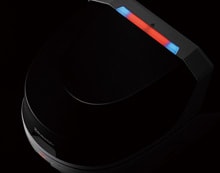
When X-rays are generated, an X-ray indicator at the rear of the instrument and an X-RAYS ON lamp at the front turn on, so that the instrument status can be monitored even from a distance.
PCEDX Navi Software Allows Easy Operation from the Start

PCEDX Navi software is designed to simplify X-ray fluorescence spectrometry for beginners, while providing the feature set and capabilities demanded by more experienced users.
The straightforward user interface offers intuitive operation and provides a convenient operating environment for beginners and experts alike.

Simple Screen Layout
Sample image display, analysis conditions selection, and sample name input on the same screen.
Collimator Switching from the Measurement Screen
Change the collimator diameter while observing the sample image.
The selected diameter is indicated by a yellow circle.
Automatic Storage of Sample Images
The sample image is loaded automatically when the measurement starts.
Sample images are saved with a link to the data file.

Once the measurement is complete, the element names, concentrations, 3σ (measurement variance) are displayed, together with the sample image, in an easy-to-understand layout.
Display the result list and individual report with a single mouse click.

Measurement Setup Screen Using the Turret (sample positioning screen)
Support for Continuous Measurements
PCEDX Navi supports measurements using the optional turret.
Switch between the sample image screen and sample positioning screen.
Unrivaled Analytical Performance
The high-performance SDD detector and optimized hardware achieve a high level of sensitivity, analysis speed, and energy resolution that were previously unattainable. It supports light element analysis of 6C to, and can be used in conjunction with the helium substitution option to analyze liquid samples containing light elements (F to Al) as is.
High Sensitivity − Lower Limit of Detection Improved 1.5 to 5 Times! −
The high-performance SDD detector and combination of optimized optics and primary filters achieve previously unheard-of high levels of sensitivity. The sensitivity is higher than the previous Si (Li) semiconductor detector across the entire range from light to heavy elements.

High Speed − Throughput Increased by up to a Factor of 10 −
The high fluorescent X-ray count per unit time (high count rate) of the SDD detector permits highly precise analysis in a shorter measurement time. This feature is achieved to the maximum when analyzing samples that generate a lot of fluorescent X-rays, such as samples with a metal as the Main component element.

Relationship Between Measurement Time and Standard Deviation
(Variance in Quantitation Values)
Comparison Using Actual Samples
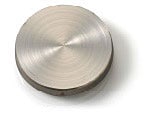
Sample External Appearance
Repeatability using the EDX-8100 and the previous model were compared for lead (Pb) in lead-free solder.
Extending the Measurement time to increase the fluorescent X-ray count can improve the precision (repeatability) of X-ray fluorescence spectrometry.
The EDX-8100 incorporates a high-count-rate SDD detector that achieves highly precise analysis of the target in a shorter Measurement time than the previous model.

Measurement time Required to Reach the Target Analysis Precision
High Resolution
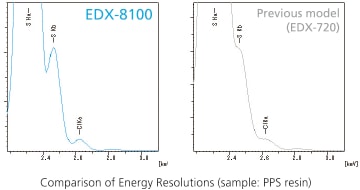
The EDX-8100 instruments achieve superior energy resolution compared to previous models by incorporating a state-of-the-art SDD detector.
This reduces the effects of overlapping peaks of different elements, enhancing the reliability of the analysis results.
No Liquid Nitrogen Required
The high fluorescent X-ray count per unit time (high count rate) of the SDD detector permits highly precise analysis in a shorter measurement time. This feature is achieved to the maximum when analyzing samples that generate a lot of fluorescent X-rays, such as samples with a metal as the Main component element.
Range of Detected Elements
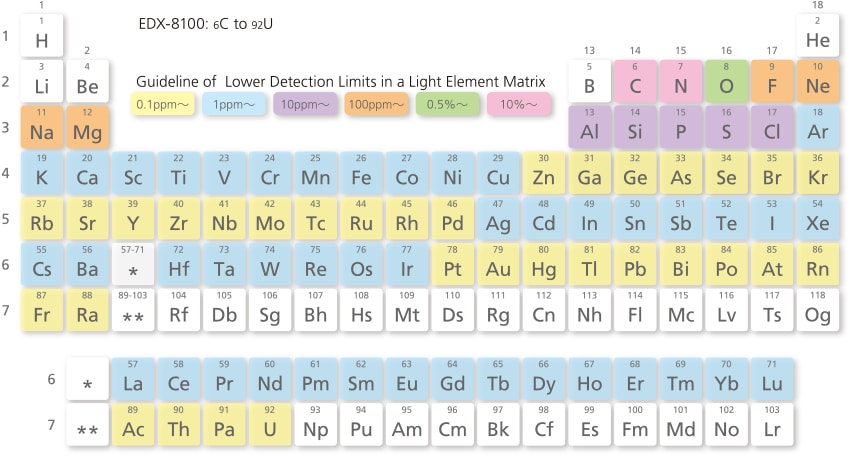
- An optional vacuum measurement unit or helium purge unit is required to measure light elements (15P and below) with the EDX-8100.
- Lower detection limit vary depending on the sample matrix or coexisting elements.
- Lower detection limit of light element (20Ca and below) get worse when the sample cell film is used.
- It is impossible to measure 8O and below with sample cell film.
Ultra-Light Element Analysis by EDX-8100

The EDX-8100 features an SDD detector with a special ultra-thin-film window material that is able to detect ultra-light elements such as carbon (C), oxygen (O), and fluorine (F)
Extremely Flexible
Accommodates all types of samples from small to large, from powders to liquids. Options include a vacuum measurement unit and helium purge unit for highly sensitive measurement of light elements and a 12-sample turret for automated continuous measurements.
Sample Observation Camera and Collimators

Automatic collimator switching in four stages: 1, 3, 5, and 10 mm diameter
Select the irradiation chamber from four values to suit the sample size.
Select the most appropriate irradiation diameter for the sample shape: 1 mm diameter for trace foreign matter analysis or defect analysis; 3 mm or 5 mm diameter for small sample volumes.
Sample observation camera included standard
Use the sample observation camera to confirm the X-ray irradiation position on a specific position to measure small samples, samples comprising multiple areas, or when using a Micro X-Cell.
Automatic Replacement of Five Primary Filters
Primary filters enhance detection sensitivity by reducing the continuous X-rays and the characteristic X-rays from the X-ray tube. They are useful for the analysis of trace elements.
The EDX-8100 incorporates five primary filters as standard (six, including the open position), which can be automatically changed using the software.
| Filter | Effective Energy (keV) | Target Elements (Examples) |
| #1 | 15 to 24 | Zr, Mo, Ru, Rh, Cd |
| #2 | 2 to 5 | Cl, Cr |
| #3 | 5 to 7 | Cr |
| #4 | 5 to 13 | Hg, Pb, Br |
| #5 | 21 to 24(5 to 13)* | Cd (Hg, Pb, Br) |
* This filter also cuts the background in the energy range shown in parentheses ( ).
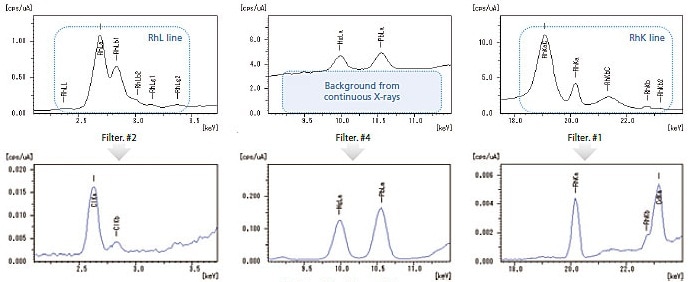
Effect of the Primary Filters
Freely Combine Collimators and Primary Filters
The collimators and primary filters are driven independently and can be combined to address specific requirements. Select the optimal combination from 24 (6 filters x 4 collimators) available options.
Quantitative analysis using the FP method is possible with all combinations.
Optional Vacuum Measurement Unit and Helium Purge Unit
Sensitivity for light elements can be increased by removing atmosphere. Two options are available: a vacuum measurement unit and a helium purge unit.
The helium purge unit is effective when measuring liquid samples and samples that generate a gas and cannot be measured in a vacuum.

Relative Sensitivity of Measurements with Helium Purging and in Air
(sensitivity in vacuum = 100)

Profile Comparison in Vacuum and Air
(sample: soda-lime glass)
Advanced Helium Purge Unit (Option)
This proprietary system (Japanese Patent No. 5962855) efficiently purges the instrument with helium gas to achieve an approximately 40 % reduction in purge time and helium gas consumption compared to previous units.
(Option for EDX-8100)

Profile Comparison in Air and Helium After Purging
(EDX-8100 / sample: fluorine in fluorine coating agent)
12-Sample Turret (Option)
The addition of the turret allows automated continuous measurements. It improves throughput, especially for measurements in a vacuum or helium atmosphere.

Comprehensive Quantitation Functions
Calibration Curve Method

A standard sample is measured and the relationship with the fluorescent X-ray intensity plotted as a calibration curve, which is used for the quantitation of unknown samples.
Although this method requires selection of a standard sample close to the unknown sample and creation of a calibration curve for each element, it achieves a high level of analysis accuracy.
This method supports all types of corrections for coexistent elements, including absorption/excitation correction and correction for overlapping elements.
Fundamental Parameter (FP) Method
This method uses theoretical intensity calculations to determine the composition from the measured intensities. It's a powerful tool for the quantitative analysis of unknown samples in cases where preparation of a standard sample is difficult. (JP No. 03921872, DE No. 60042990. 3-08, GB No. 1054254, US No. 6314158)
Automatic Balance Setting Function (Patent pending)
A balance setting is required to use the FP method on principal components such as C, H, and O. The software automatically sets the balance if it determines from the profile shape that a balance setting is required.
Film FP Method
The instrument also offers the thin-film FP method function. The film FP method permits the film thickness measurement of multilayer films, and simultaneous film thickness measurements and quantitative film composition.
When using the film FP method, the substrate material, deposition sequence, and element information can be set.
Background FP Method

The background FP method adds scattered X-ray (background) calculations to the conventional FP method, which only calculates the fluorescent X-ray peak intensity (net peak intensity).
(Patent pending: Japanese Patent No. 5975181)
This method is effective at improving quantitation accuracy for small quantities of organic samples, film thickness measurements of irregular-shaped plated samples, and film thickness measurements of organic films.
Matching Function

Matching Results
The matching function compares analysis data for a sample with an existing data library and displays the results in descending degree of confidence.
The library contains content data and intensity data and the user can register each type. The content data values can be entered manually.
Functions to Enhance Usability
Easy Instrument Startup

PCEDX Navi offers instrument initialization and startup (X-ray startup) with simple mouse-click operations.
After instrument startup, the stabilization function operates for 15 minutes. Analysis and instrument checks are disabled during this period, ensuring that all users collect data in a stable instrument environment.
Automatic X-ray Tube Aging
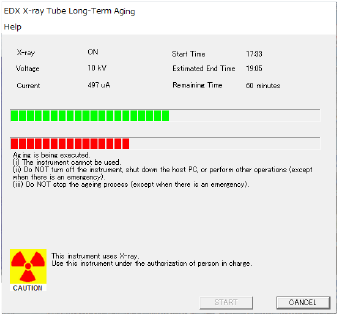
When an X-ray tube has not been used for a long period, it requires aging before it can be used again. The software automatically performs the appropriate aging according to the period of non-use.
Condition Password Protection

The software offers password protection. Condition settings and changes can only be made by a person who enters the password.
Incorporates General Analysis Software

EDX-8100 incorporates PCEDX Pro software that has more flexibility functions. This software offers analysis, conditions settings, and data processing using familiar operations. It also allows loading of data profiles and quantitation values acquired with a previous Shimadzu EDX series instrument.
Various Data Output Formats
Report Creation Functions
Analysis data reports can be created in HTML or Excel format. A variety of templates is available.
The sample image automatically saved when measurement started is pasted in the report for confirmation of the measurement position.

RoHS Screening Report in Excel Format
* Microsoft Office Excel must be purchased separately.

General Analysis Report in HTML Format
List Creation Functions
Lists of the analysis results for multiple samples can be created in Excel format. Data can be selected in the list for detailed display or editing. A variety of list generation templates is available, including a list of RoHS specific hazardous elements and user-defined lists of elements.

User-Definable List of Elements


